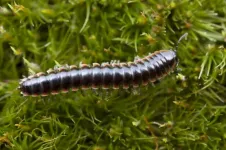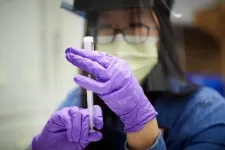Through the project, called North Carolina Candid Critters, researchers trained 580 volunteers to take candid animal photos with heat sensitive cameras, and then share their photos through a website called eMammal. In an article on the project in the journal Citizen Science: Theory and Practice, researchers reported on the successes and challenges of the effort, which gathered more than 2.2 million wildlife photos across three years, and increased the number of verified mammal records that were available in the state by a factor of five.
"The power of this is that you can get large-scale, ecological data in a timely manner," said the study's corresponding author Roland Kays, research associate professor at NC State. "There are many people interested in using citizen science, but there are a lot of questions such as: How do you train the volunteers? How do you get the data from them? This paper was really about how we addressed those questions as the project went on, and what were some of the solutions that we found for dealing with them."
Through the project, researchers recruited volunteers including library patrons, middle school students, teachers, hikers and nature enthusiasts from all 100 counties. They created a customized online program to train volunteers to place and use the cameras, which they loaned out through 63 public libraries. Some volunteers used their own cameras. The project was a collaboration with the N.C. Wildlife Resources Commission, N.C. Museum of Natural Sciences, eMammal and N.C. Cardinal Libraries.
"We're the first citizen science project to loan out equipment on that kind of scale," Kays said.
The volunteers placed cameras at 3,093 locations. Along with additional work by research staff, they were able to get photos from a total of 4,295 locations. While they worked with federal and state agencies, nonprofits and private landowners to get permission for people to place cameras on public and private land, many people placed cameras by their homes. Fifty-four percent of volunteers placed cameras on private land.
"It's really hard to sample on private land because it's hard to get permission," Kays said. "In this case, people were putting cameras on their own land because they wanted to see what animals were there. That's a real bonus of the citizen science approach."
Of 2.2 million photos taken, 1.4 million were taken by volunteers, and the rest were captured by staff. From those photos, they were able to get 120,671 wildlife observations, with 45 percent of those taken by volunteers. That included 30 different mammal and three bird species.
Researchers double-checked volunteers' photos to make sure the cameras were placed correctly, and the animals were correctly identified. Researchers rejected less than 1 percent of camera placements for being set too low, 3.2 percent for being set too high, and 4.9 percent for equipment malfunctions, including cameras being destroyed by bears.
"Volunteers might not do everything perfectly the first time," Kays said. "The nice thing was that via the eMammal system, we could check to see if the camera was set up correctly. We could tell the volunteer, and the next time it would get better. We were able to verify the information and give feedback to volunteers."
They found volunteers identified animals with 69.7 percent accuracy. While volunteers tended to identify certain species, such as the white-tailed deer and wild turkey, correctly every time, others were trickier. They identified the North American river otter with just 56 percent accuracy.
Researchers faced challenges in recruiting volunteers, training them, managing the camera equipment and in making sure they got photos in locations where they needed, including in forests, open land and developed areas. To help other researchers, they suggested solutions for how to recruit volunteers, gather data and overcome other obstacles.
"Data management was a huge challenge, which we addressed using the eMammal system," Kays said. "Training was a problem we still have to work on. Some people dropped out because the training was too complicated."
The photos will be used for multiple research projects to answer questions about wildlife abundance, reproduction and other questions. The data will be made publicly available for other researchers to use.
"The great potential of citizen science is it can help you collect more data than you could before, across a larger area more rapidly, and on different areas like on private land," Kays said. "It also engages the public, and it get them interested in science and science around nature and conservation."
INFORMATION:
The study, "Candid Critters: Challenges and Solutions in a Large-Scale Citizen Science Camera Trap Project," was published online Feb. 26 in Citizen Science: Theory and Practice. It was authored by Kays along with Monica Lasky and Arielle Parsons, Lincoln Larson, Brent Pease, Hailey Boone and Alexandra Mash of NC State; Stephanie Schuttler Ben Norton and Lisa Gatens of the N.C. Museum of Natural Sciences. Funding was provided partially through a Pittman-Robertson Wildlife Restoration Grant.
-oleniacz-
Note to editors: The abstract follows.
"Candid Critters: Challenges and Solutions in a Large-Scale Citizen Science Camera Trap Project."
Published online Feb. 26 in Citizen Science: Theory and Practice.
Authors: Monica Lasky, Arielle Parsons, Stephanie Schuttler, Alexandra Mash, Lincoln Larson, Ben Norton, Brent Pease, Hailey Boone, Lisa Gatens and Roland Kays.
DOI: 10.5334/cstp.343
Abstract: Citizen science projects that use sensors (such as camera traps) to collect data can collect large-scale data without compromising information quality. However, project management challenges are increased when data collection is scaled up. Here, we provide an overview of our efforts to conduct a large-scale citizen science project using camera traps--North Carolina's Candid Critters. We worked with 63 public libraries to distribute camera traps to volunteers in all 100 counties in North Carolina, USA. Candid Critters engaged 580 volunteers to deploy cameras at 4,295 locations across private and public lands, collecting 120,671 wildlife records and 2.2 million photographs. We provide eight key suggestions for overcoming challenges in study design, volunteer recruitment and management, equipment distribution, outreach, training, and data management. We found that citizen science was a successful and economical method for collecting large-scale wildlife records, and the use of sensors allowed for inspectable quality and streamlined acquisition. In three years, we collected roughly five times the number of verified mammal records than were previously available in North Carolina, and completed the work for less than the typical cost of collecting data with field assistants. The project also yielded many positive outcomes for adult and youth volunteers. Although citizen science presents many challenges, we hope that sharing our experiences will provide useful insight for those hoping to use sensors for citizen science over large scales.


